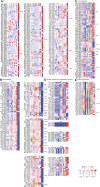Transcriptomic and functional analyses reveal the molecular mechanisms underlying Fe-mediated tobacco resistance to potato virus Y infection
- PMID: 37063211
- PMCID: PMC10098458
- DOI: 10.3389/fpls.2023.1163679
Transcriptomic and functional analyses reveal the molecular mechanisms underlying Fe-mediated tobacco resistance to potato virus Y infection
Abstract
Potato virus Y (PVY) mainly infects Solanaceous crops, resulting in considerable losses in the yield and quality. Iron (Fe) is involved in various biological processes in plants, but its roles in resistance to PVY infection has not been reported. In this study, foliar application of Fe could effectively inhibit early infection of PVY, and a full-length transcriptome and Illumina RNA sequencing was performed to investigate its modes of action in PVY-infected Nicotiana tabacum. The results showed that 18,074 alternative splicing variants, 3,654 fusion transcripts, 3,086 long non-coding RNAs and 14,403 differentially expressed genes (DEGs) were identified. Specifically, Fe application down-regulated the expression levels of the DEGs related to phospholipid hydrolysis, phospholipid signal, cell wall biosynthesis, transcription factors (TFs) and photosystem I composition, while those involved with photosynthetic electron transport chain (PETC) were up-regulated at 1 day post inoculation (dpi). At 3 dpi, these DEGs related to photosystem II composition, PETC, molecular chaperones, protein degradation and some TFs were up-regulated, while those associated with light-harvesting, phospholipid hydrolysis, cell wall biosynthesis were down-regulated. At 9 dpi, Fe application had little effects on resistance to PVY infection and transcript profiles. Functional analysis of these potentially critical DEGs was thereafter performed using virus-induced gene silencing approaches and the results showed that NbCat-6A positively regulates PVY infection, while the reduced expressions of NbWRKY26, NbnsLTP, NbFAD3 and NbHSP90 significantly promote PVY infection in N. benthamiana. Our results elucidated the regulatory network of Fe-mediated resistance to PVY infection in plants, and the functional candidate genes also provide important theoretical bases to further improve host resistance against PVY infection.
Keywords: Fe; Illumina RNA sequencing; PVY; full-length transcriptome; virus-induced gene silencing.
Copyright © 2023 Xu, Guo, Li, Lan, Zhang, Xie, Zhu, Mu, Wang, An, Xia and Wu.
Conflict of interest statement
Authors CX, YZ and QX were employed by company Luzhou City Company of Sichuan Province Tobacco Company. Authors DZ and QM were employed by company Guizhou Qianxinan Prefectural Tobacco Company. The remaining authors declare that the research was conducted in the absence of any commercial or financial relationships that could be construed as a potential conflict of interest.
Figures









Similar articles
-
Transcriptome analysis and functional verification reveal the roles of copper in resistance to potato virus Y infection in tobacco.Pestic Biochem Physiol. 2024 May;201:105893. doi: 10.1016/j.pestbp.2024.105893. Epub 2024 Mar 31. Pestic Biochem Physiol. 2024. PMID: 38685255
-
Transcriptome sequencing and functional verification revealed the roles of exogenous magnesium in tobacco anti-PVY infection.Front Microbiol. 2023 Jul 27;14:1232279. doi: 10.3389/fmicb.2023.1232279. eCollection 2023. Front Microbiol. 2023. PMID: 37577430 Free PMC article.
-
Transcriptome and Small RNA Profiling of Potato Virus Y Infected Potato Cultivars, Including Systemically Infected Russet Burbank.Viruses. 2022 Mar 3;14(3):523. doi: 10.3390/v14030523. Viruses. 2022. PMID: 35336930 Free PMC article.
-
Insight into aphid mediated Potato Virus Y transmission: A molecular to bioinformatics prospective.Front Microbiol. 2022 Nov 24;13:1001454. doi: 10.3389/fmicb.2022.1001454. eCollection 2022. Front Microbiol. 2022. PMID: 36504828 Free PMC article. Review.
-
Potato Virus Y Emergence and Evolution from the Andes of South America to Become a Major Destructive Pathogen of Potato and Other Solanaceous Crops Worldwide.Viruses. 2020 Dec 12;12(12):1430. doi: 10.3390/v12121430. Viruses. 2020. PMID: 33322703 Free PMC article. Review.
Cited by
-
Transcriptomic insights into the molecular mechanism for response of wild emmer wheat to stripe rust fungus.Front Plant Sci. 2024 Jan 3;14:1320976. doi: 10.3389/fpls.2023.1320976. eCollection 2023. Front Plant Sci. 2024. PMID: 38235210 Free PMC article.
-
Transcriptome analysis of genes involved in the pathogenesis mechanism of potato virus Y in potato cultivar YouJin.Front Microbiol. 2024 Mar 6;15:1353814. doi: 10.3389/fmicb.2024.1353814. eCollection 2024. Front Microbiol. 2024. PMID: 38511006 Free PMC article.
-
Transcriptome Analysis of Tomato Leaves Reveals Candidate Genes Responsive to Tomato Brown Rugose Fruit Virus Infection.Int J Mol Sci. 2024 Apr 4;25(7):4012. doi: 10.3390/ijms25074012. Int J Mol Sci. 2024. PMID: 38612822 Free PMC article.
-
HSP90 interacts with VP37 to facilitate the cell-to-cell movement of broad bean wilt virus 2.mBio. 2025 Mar 12;16(3):e0250024. doi: 10.1128/mbio.02500-24. Epub 2025 Feb 19. mBio. 2025. PMID: 39969167 Free PMC article.
References
LinkOut - more resources
Full Text Sources

